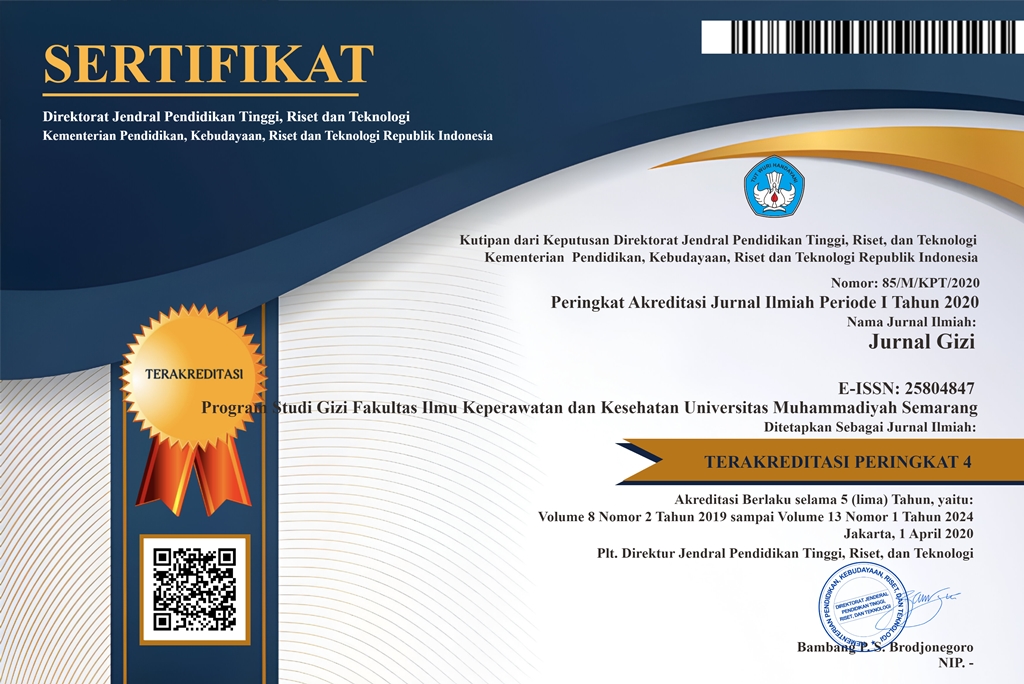Nilai Gizi dan Sifat Organoleptik Yoghurt dari Rasio Tepung Tulang Ikan Nila (Oreochromis sp) dan Kacang Hitam (Phaseolus vulgaris ‘Black turtle)
(1)
(2)
(3)
(*) Corresponding Author
Abstract
Yogurt made from milk which is fermented by lactic acid bacteria. However, other plant protein source such as black bean (BB) is potential to be used and can be mixed with tilapia fish (TF) to formulate protein source yoghurt. This study aimed to examine the effect of ratio BB and TF toward the yoghurt’s nutritional content and sensory properties. This experimental
study comprised from five formulations of ratio of BB and TF flour, T0 (BB 0%: TF 0%) T1 (BB 0%: TF 25%), T2 (BB 5%: TF 20%), T3 (BB 10%: TF 15 %), and T4 (BB 15%: TF 10%).
Sensory properties was tested by 34 semi-trained panelists and measured by Visual Analog Scale (VAS). Data was analyzed by One way Anova test. Result showed that T1 was the most preferred. There was a significant effect from ratio of BB and TF on sensory parameter (taste, aroma, color, texture and overall product) (p <0.05). T1 had a viscosity of 53.49 cP, contained protein 8.06%, fat 0.85%, carbohydrates 10.85%, moisture 79.26%, ash 0.07%. The conclusion is ratio of BB and TF had an effect on the nutritional content and sensory properties.
Keywords: Yogurt, tilapia bone flour, black beans
study comprised from five formulations of ratio of BB and TF flour, T0 (BB 0%: TF 0%) T1 (BB 0%: TF 25%), T2 (BB 5%: TF 20%), T3 (BB 10%: TF 15 %), and T4 (BB 15%: TF 10%).
Sensory properties was tested by 34 semi-trained panelists and measured by Visual Analog Scale (VAS). Data was analyzed by One way Anova test. Result showed that T1 was the most preferred. There was a significant effect from ratio of BB and TF on sensory parameter (taste, aroma, color, texture and overall product) (p <0.05). T1 had a viscosity of 53.49 cP, contained protein 8.06%, fat 0.85%, carbohydrates 10.85%, moisture 79.26%, ash 0.07%. The conclusion is ratio of BB and TF had an effect on the nutritional content and sensory properties.
Keywords: Yogurt, tilapia bone flour, black beans
Full Text:
PDFArticle Metrics
Abstract view : 1780 timesPDF - 371 times
DOI: https://doi.org/10.26714/jg.8.1.2019.%25p
Refbacks
- There are currently no refbacks.
Diterbitkan oleh: Program Studi Gizi (D3 dan S1)
Fakultas Ilmu Keperawatan dan Kesehatan
Universitas Muhammadiyah Semarang
Sekretariat: Jl. Kedungmundu Raya No. 18 Semarang
Contact Person : Hapsari Sulistya Kusuma, S.Gz, M.Si (+62 85 6 41 536 553)

This work is licensed under a Creative Commons Attribution 4.0 International License.









.png)
.png)